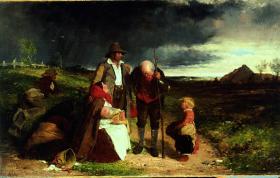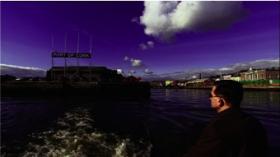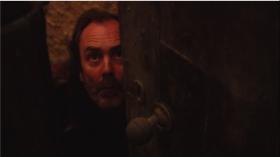TV Eye
Published in 18th-19th Century Social Perspectives, 18th–19th - Century History, General, Issue 6 (Nov/Dec 2008), Reviews, The Famine, Volume 16
Detail from The Eviction by Erskine Nicol (1853). We learned that at the height of the potato famine the Mahon family of Strokestown House, who evicted 3,000 people in 1847, were still able to dine on lobster soup. (National Gallery of Ireland)
Where was your family during the famine?
Animo Television
8 September 2008, RTÉ 1
by John Gibney
The notion of tracing one’s ancestors in any kind of formalised way can easily prompt Irish people to cynicism, usually (and unfairly) directed at Irish-Americans. But the US is fertile ground for genealogy, for in a country where many citizens characterise themselves according to ethnic affiliations that are usually only a few generations old the idol of origins is alluring. Who arrived when, and from where? For Americans, their lineage will stretch across both time and space, to very different countries from the one that eventually arose from the nineteenth-century ‘melting pot’. On the other hand, Irish people who might be inclined to trace their ancestry are probably going to range over more time than space. Where was your family during the famine? took three rather different individuals—financial consultant Eddie Hobbs, journalist John Waters and model Jasmine Guinness—and attempted to answer the titular question by tracing their ancestry back to the Great Famine of the 1840s.
This documentary was the de facto prelude to an RTÉ version of the BBC’s Who do you think you are?, which traced the ancestry of a number of prominent individuals, not all of whom were actually employed by RTÉ: Charlie Bird, Joe Duffy, Dana Rosemary Scallon and Ardal O’Hanlon, to name but four. Admittedly, their family trees proved to be surprisingly interesting, but the approach taken by the subsequent series tended to treat their subjects as little more than historical ‘human interest’ stories, which arguably did them a disservice. On the other hand, Where was your family during the famine?, made as it was by a different production company, proved to be a far more penetrating and revealing piece of work.

Financial consultant Eddie Hobbs—his great-grandfather, John Hobbs, had been a weighmaster in the Cork butter market. In a single day in November 1848, 2,324 barrels of butter, amongst many other foodstuffs, were exported from Cork. (Animo Television)
There were obvious differences between Hobbs, Guinness and Waters, in terms of both their occupations and their backgrounds. All had one thing in common, however: the lack of a connection with crucial aspects of their ancestry. There were a number of reasons for this: family lore not being passed down through generations; discreet and uncomfortable silences that had the same result; the death of relatives who could have provided a living link to the past; or simply the descent into obscurity that comes with the passage of time. As inquiries amongst their respective families seemed to prove increasingly fruitless, these gave way to genealogical research, carried out for both this and Who do you think you are? by the historical research and consultancy firm Eneclann. One of the strengths of Where was your family during the famine? was that, whether by accident or design, it illustrated the process by which genealogy in Ireland can piece together a family tree. As the link to the period of the Famine was established, however, another crucial issue hove into view: the fact that the lives of those ordinary people who make up the majority of any dead generation tend to remain in the shadows. While genealogy could supply the formal continuity between past and present, there came a point where a leap of imagination would be required to make sense of the scattered fragments of evidence that had been revealed. The three distinct stories were intercut with one another, but all followed a similar trajectory as Hobbs, Guinness and Waters attempted to make sense of what they were finding out.

Journalist John Waters searches through the ruins of Sligo’s workhouse. His ancestors were drawn from the county’s small farmers. (Animo Television)
Eddie Hobbs’s great-grandfather, John Hobbs, had been a weighmaster in the Cork butter market (an institution of virtually global significance), and managed to prosper despite a famine that saw Cork barricade itself from refugees and expel victims of ‘contagion’. Guinness, who came from a mixture of Irish, Anglo-Irish and German stock, was primarily concerned with her obscure maternal lineage rather than with her more obvious connection to a certain family of brewers. Indeed, her mother joined her in order to find out about the Casey family from which she came; they were traced back to a nationalist family in Belfast who had apparently been driven out of the city in the 1920s, thence back to a moderate degree of prosperity in rural Tyrone: that relative prosperity in the midst of a county that suffered horrendously ensured their survival. Waters found his own ancestors amidst the small farmers of Sligo. Yet the significance of the stories of the three families was not in their conclusion so much as in the journey that brought them there.
With regard to the Famine itself, academics such as Kevin Whelan of Notre Dame and Larry Geary of UCC were on hand to provide vivid analyses that shed light on the various facets of social history touched on by the documentary. Yet it remained non-judgemental; stark facts were allowed to speak for themselves, and conclusions were left to the three individuals at the heart of it. A recurrent feature was that all three narrated often horrific contemporary accounts of the Famine in the areas relevant to their search; all were visibly affected by what they were learning. It is sobering to learn that in the period 1841–51 the population of Waters’s home county of Roscommon dropped from 253,591 to 173,436, or that at the height of the potato famine the Mahon family of Strokestown House, who evicted 3,000 people in 1847, were still able to dine on lobster soup (the recipe was produced). Famine did not automatically equate with absolute scarcity: in a single day in November 1848, 2,324 barrels of butter, amongst many other foodstuffs, were exported from Cork—a particularly relevant fact given the occupation of Hobbs’s ancestor. As these hitherto unfamilar stories came to light, it was impossible not to wonder how such personalised inquiries into an unknown past will alter or shape the identity of those who might look for them. It is a question applicable to any time and any place. It seemed particularly to preoccupy Waters, who came across as perhaps the most cerebral of the three. But it also weighed upon the slightly shaken figure of the normally assured Hobbs, to whom the last word and image was left, as he stood amidst a mass Famine grave in Cork poignantly marked, as he himself observed, by ‘daffodils instead of headstones’. Narrated by Mick Lally, this was a powerful, original and successful attempt to make sense of three separate stories that made up three parts of the greater story of what is essentially the most important event in modern Irish history.
John Gibney is an IRCHSS Government of Ireland fellow at the Moore Institute for Research in the Humanities and Social Studies, NUI Galway.
















